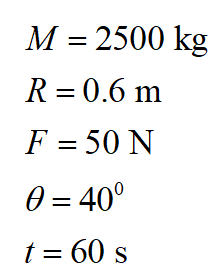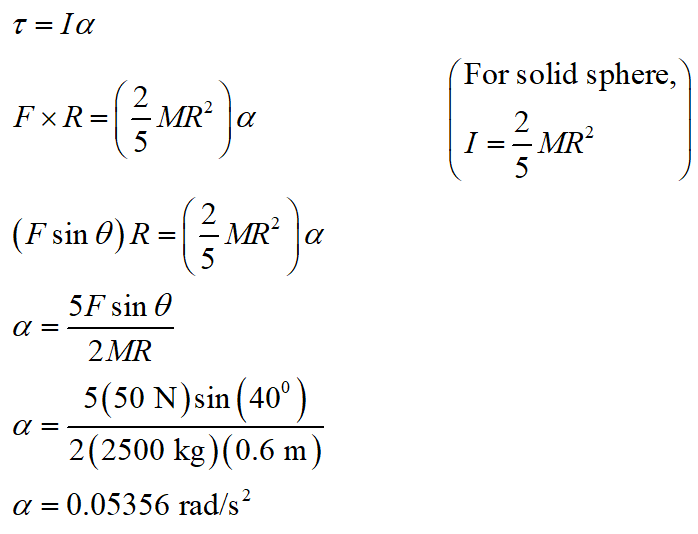At a museum there is an installation which consists of a giant solid granite sphere (with a radius of 0.6 m and a mass of 2500 kg) that is lifted slightly off a stone base by powerful jets of water. If you apply an average force of 50 N to the rightmost edge of the sphere at a 40° above the horizontal for a total of 60 s, what is the final angular speed of the sphere in rotations per minute (rpm), assuming it is not spinning when you begin pushing?
At a museum there is an installation which consists of a giant solid granite sphere (with a radius of 0.6 m and a mass of 2500 kg) that is lifted slightly off a stone base by powerful jets of water. If you apply an average force of 50 N to the rightmost edge of the sphere at a 40° above the horizontal for a total of 60 s, what is the final angular speed of the sphere in rotations per minute (rpm), assuming it is not spinning when you begin pushing?
Principles of Physics: A Calculus-Based Text
5th Edition
ISBN:9781133104261
Author:Raymond A. Serway, John W. Jewett
Publisher:Raymond A. Serway, John W. Jewett
Chapter10: Rotational Motion
Section: Chapter Questions
Problem 10P: A wheel 2.00 m in diameter lies in a vertical plane and rotates about its central axis with a...
Related questions
Question
Q 5

Transcribed Image Text:At a museum there is an installation which consists of a giant solid granite sphere (with a radius of 0.6
m and a mass of 2500 kg) that is lifted slightly off a stone base by powerful jets of water. If you apply
an average force of 50 N to the rightmost edge of the sphere at a 40° above the horizontal for a total
of 60 s, what is the final angular speed of the sphere in rotations per minute (rpm), assuming it is not
spinning when you begin pushing?
Expert Solution
Step 1
Given information:

Here, M and R are the mass and the radius of the giant solid sphere, F is the force applied, θ is the angle at which the force is applied and t is the time till the force is applied.
Step 2
Write Newton’s second law (rotational form) and plug the knowns to compute the angular acceleration (α) of the solid sphere.

Step by step
Solved in 3 steps with 3 images

Knowledge Booster
Learn more about
Need a deep-dive on the concept behind this application? Look no further. Learn more about this topic, physics and related others by exploring similar questions and additional content below.Recommended textbooks for you

Principles of Physics: A Calculus-Based Text
Physics
ISBN:
9781133104261
Author:
Raymond A. Serway, John W. Jewett
Publisher:
Cengage Learning

Physics for Scientists and Engineers: Foundations…
Physics
ISBN:
9781133939146
Author:
Katz, Debora M.
Publisher:
Cengage Learning

College Physics
Physics
ISBN:
9781305952300
Author:
Raymond A. Serway, Chris Vuille
Publisher:
Cengage Learning

Principles of Physics: A Calculus-Based Text
Physics
ISBN:
9781133104261
Author:
Raymond A. Serway, John W. Jewett
Publisher:
Cengage Learning

Physics for Scientists and Engineers: Foundations…
Physics
ISBN:
9781133939146
Author:
Katz, Debora M.
Publisher:
Cengage Learning

College Physics
Physics
ISBN:
9781305952300
Author:
Raymond A. Serway, Chris Vuille
Publisher:
Cengage Learning

University Physics Volume 1
Physics
ISBN:
9781938168277
Author:
William Moebs, Samuel J. Ling, Jeff Sanny
Publisher:
OpenStax - Rice University

Glencoe Physics: Principles and Problems, Student…
Physics
ISBN:
9780078807213
Author:
Paul W. Zitzewitz
Publisher:
Glencoe/McGraw-Hill

College Physics
Physics
ISBN:
9781938168000
Author:
Paul Peter Urone, Roger Hinrichs
Publisher:
OpenStax College